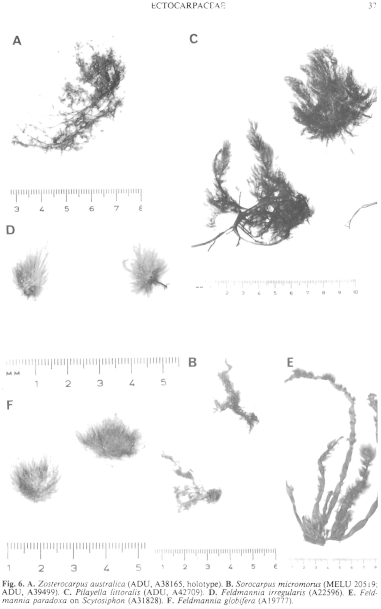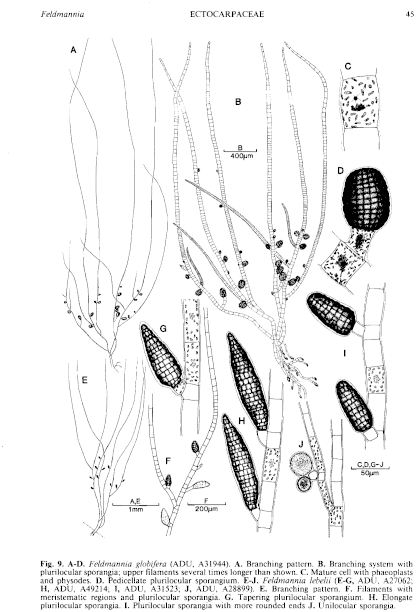|
|
|
|
|
|||||||||||
|
Electronic Flora of South Australia Species Fact Sheet
Phylum Phaeophyta – Order Ectocarpales
Selected citations: Cardinal 1964: 57, figs 31, 32. Clayton 1974: 754, fig. 3. King & Ducker 1971: 115. Knoepfller-Péguy 1970: 174. Kuckuck 1958: 179, figs 5–10. Womersley 1967: 191.
Synonyms
Ectocarpus globifer Kützing. Hamel 1931: 49, fig. 15E. Sauvageau 1933: 93, figs 22, 23.
Feldmannia simplex (Crouan & Crouan) Hamel 1939b: xviii, fig. 61H. Cardinal 1964: 55, fig. 30. Clayton 1974: 754, fig. 4. Knoepffler-Péguy 1970: 176. Womersley 1967: 192.
Ectocarpus simplex Crouan & Crouan. Hamel 1931: 50, fig. 15A–D. Sauvageau 1933: 80, figs 17–21.
Thallus (Fig. 6F) medium to dark brown, forming tufts 0.5–2 cm long, irregularly branched close to the compact, entangled base and with long, unbranched filaments (Fig. 9A) with a single meristematic region near their bases (Fig. 9B), usually epiphytic and attached by rhizoids. Filaments (Fig. 9B) (24–) 30–50 (–60) µm in diameter with cells L/B 1–2.5 (–4), in terminal filaments 30–55 (–60) µm in diameter with cells L/B (1.5–) 2–2.5 (–4), of fairly uniform diameter but gently tapering above. Growth (Fig. 9B) from distinct single meristems at the base of each terminal filament. Cells (Fig. 9C) with numerous discoid to elongate (L/B up to 2.5) phaeoplasts each with a pyrenoid, and centrally aggregated physodes.
Reproduction: Plurilocular sporangia (Fig. 9D) usually with a one (–3) celled pedicel (occasionally sessile), globular to ovoid with broadly rounded apex, 60–90 (–100) µm long and 50–80 µm in diameter. Unilocular sporangia rare, sessile, ovoid, 35–60 m in diameter.
Type from Spalato (Split), Yugoslavia; in L.
Selected specimens: Elliston, S. Aust., on Codium galeatum, upper sublittoral (Parsons, 24.viii.1967; ADU, A31944). Port Hughes, S. of Wallaroo, S. Aust., 1–3 m deep (Gordon-Mills, 22.xii.1983; ADU, A55415-"Marine Algae of southern Australia" No. 248). Christies
Distribution: Widespread in temperate seas.
In southern Australia, from Elliston, S. Aust., to Mallacoota, Vic. and around Tasmania.
Taxonomic notes: Beach, S. Aust., upper sublittoral pools ( Womersley, 14.x.1968; ADU, A32874). American R. inlet, Kangaroo I., S. Aust., on buoy (Womersley, 17.viii.1954; ADU, A19777). Point Bunbury, Apollo Bay, Vic., on Codium fragile, upper sublittoral pool (Womersley, 12.iv.1959; ADU, A22647). Remine, Tas., on Codium fragile, reef pools ( Wollaston & Mitchell, 25.ii.1964; ADU, A27516).
Clayton (1974, p. 754) has discussed the degree of variation in shape of plurilocular sporangia in this complex and considers that these species cannot be kept separate. However, it is possible that some specimens placed by Clayton as F. simplex (e.g. her Fig. 4B,C) would be here placed under F. lebelii (see below). The filament diameter within F. globifera is usually within the range 26–58 (as in Clayton Fig. 4A) whereas F. lebelii is 14–20 (–24) µm in diameter (as in Clayton Fig. 4B) with elongate, tapering sporangia (as in Clayton Fig. 4C).
Clearly further studies are necessary of this complex and its variation using living or preserved material.
References:
CARDINAL, A. (1964). Étude sur les Ectocarpacees de la Manche. Nova Hedwigia 15, 1–86, Figs. 1–41.
CLAYTON, M.N. (1974). Studies on the development, life history and taxonomy of the Ectocarpales (Phaeophyta) in southern Australia. Aust. J. Bot. 22, 743–813.
HAMEL, G. (1931). Phéophycées de France. Fasc. I, pp. 1–80. (Paris.)
HAMEL, G. (1939b). Phéophycées de France. Fasc. V, pp. 337–432, i-xlvii. (Paris.)
KING, R.J. & DUCKER, S. (1971). In King, R.J., Black, J.H. & Ducker, S. Intertidal ecology of Port Phillip Bay, with systematic lists of plants and animals. 3. Flora of the intertidal region, pp. 112–128. Mem. Nat. Mus. Vic. 32, 93–128.
KNOEPFFLER-PÉGUY, M. (1970). Quelques Feldmannia Hamel, 1939 (Phaeophyceae-Ectocarpales) des côtes d'Europe. Vie et Milieu Sér. A. 21, 137–188.
KUCKUCK, P. (1958). Herausgegeben von P. Kornmann. Ectocarpaceen-Studien V. Kuckuckia, Feldmannia. Helgol. wiss. Meeresunters. 6, 171–192.
SAUVAGEAU, C. (1933). Sur quelques Algues phéosporées de Guethary (Basses-Pyrenees). Bull. Stn biol. Arcachon 30, 1–128.
WOMERSLEY, H.B.S. (1967). A critical survey of the marine algae of southern Australia. II. Phaeophyta. Aust. J. Bot. 15, 189–270.
The Marine Benthic Flora of Southern Australia Part II complete list of references.
Publication:
Womersley, H.B.S. (14 December, 1987)
The Marine Benthic Flora of Southern Australia
Part II
©Board of the Botanic Gardens and State Herbarium, Government of South Australia
Illustrations in Womersley Part II, 1997: FIGS 6F, 9 A–D.

Figure 6 enlarge
Fig. 6. A. Zosterocarpus australica (ADU, A38165, holotype). B. Sorocarpus micromorus (MELU 20519; ADU, A39499). C. Pilayella littoralis (ADU, A42709). D. Feldmannia irregularis (A22596). E. Feldmannia paradoxa on Scytosiphon (A31828). F. Feldmannia globifera (A19777).

Figure 9 enlarge
Fig. 9. A–D. Feldmannia globifera (ADU, A31944). A. Branching pattern. B. Branching system with plurilocular sporangia; upper filaments several times longer than shown. C. Mature cell with phaeoplasts and physodes. D. Pedicellate plurilocular sporangium. E–J. Feldmannia lebelii (E–G, ADU, A27062; H, ADU, A49214; I, ADU, A31523; J, ADU, A28899). E. Branching pattern. F. Filaments with meristematic regions and plurilocular sporangia. G. Tapering plurilocular sporangium. H. Elongate plurilocular sporangia. I. Plurilocular sporangia with more rounded ends J. Unilocular sporangia.

|
Email Contact: State Herbarium of South Australia |

|